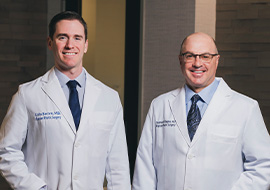Common Questions
What is the difference between an eyelid lift, blepharoplasty and ptosis surgery? Will eyelid surgery correct my droopy eyebrow? What are the risks of eyelid surgery?
Thyroid Eye Disease
Eyelid Retraction Repair and Orbital Decompression Surgery
Upper Eyelid Surgery
To improve upper eyelid retraction, surgical loosening of the upper eyelid retractor muscles (levator muscle and Mueller’s muscle) and release of scar tissue in the muscles can allow the upper eyelids to come down to a more normal level. This surgery is typically performed with local injections and minimal IV sedation in order to permit patient cooperation during the surgery. Patients are placed in a sitting upright position at the end of surgery to ensure adequate surgical correction. Adjustments made during surgery diminish the risk of asymmetry following surgery. Despite meticulous attention to eyelid height during surgery, the eyelids may heal differently resulting in eyelid asymmetry. Frequently, the asymmetry is not bothersome and further surgery can be avoided. In up to 10-15% of patients, additional “touch-up” procedures may be needed to correct significant asymmetries. Significant upper eyelid retraction repair is typically considered medically necessary and is usually covered by most insurance carriers. Mild cases of eyelid retraction may be considered cosmetic.
At the time of upper eyelid retraction repair, patients may elect to have excessive fatty tissue and redundant skin folds excised. Upper eyelid blepharoplasty is frequently considered cosmetic and not covered by most insurance carriers.
Lower Eyelid Surgery
The same puffiness and tissue response that occurs in the upper eyelids may also develop in the lower eyelids. Lower eyelid retraction may result in exposure of the white portion of the eye. This may contribute to eye exposure, dryness, and irritation. Surgical procedures can improve the protection of the eye and the appearance of the lower eyelid. With lower eyelid surgery, the scarred muscle can be loosened and spacer material inserted to boost the eyelid upward.
Spacer grafts used might include ear cartilage. To be able to reposition the outer edge of the lower eyelid upward, the outside tendon must be tightened. Despite meticulous measurements of spacer materials, the eyelids may heal differently resulting in eyelid asymmetry. Frequently, the asymmetry is not bothersome and further surgery can be avoided. Additional “touch-up” procedures are infrequently indicated to correct significant asymmetries. Significant lower eyelid retraction repair is typically considered medically necessary and is usually covered by most insurance carriers.
At the time of lower eyelid retraction repair, patients may elect to have excessive fatty tissue and redundant skin folds excised. Lower eyelid blepharoplasty is frequently considered cosmetic and not covered by most insurance carriers.
Orbital Decompression Surgery
Orbital decompression surgery can often improve proptosis by enlarging the eye socket (orbit) to accommodate the swollen fat and muscle tissues behind the eye. This allows the eye to settle back into a more comfortable position. The consistency and amount of fat varies from case to case and will impact the degree of decompression achieved by surgery. Individuals with thicker, stiff fat may not experience as much decompression effect as those with large amounts of softer, more ‘fluid-like’, fat tissue.
Around the orbit (the bone socket in which the eyeball sits) there are a number of sinus (air) cavities that can be used to surgically expand the orbit. The sinus below the eye is called the maxillary sinus and the sinus toward the nose is called the ethmoidal sinus. A maxillary-ethmoidal bone decompression is a well-recognized approach for accommodating the extra tissues behind the eye. Most people only require a two wall, maxillary-ethmoidal decompression; occasionally, the outside (lateral) wall of the orbit may also be removed.
The surgical method Klapper Eyelid & Facial Plastic Surgery utilizes to remove the bone of the orbital floor (underneath the eye) involves an incision on the inside of the eyelid and a very small skin incision near the outer corner of the eye. This skin incision heals nicely within the normal laugh lines around the eye. Using eyeglasses with magnification, the surgeon will meticulously remove the bone of the orbital floor to allow communication with the maxillary sinus air cavity.
There is a nerve that runs through this bone to provide sensation to the cheek, lip, and upper teeth. Great care is taken to meticulously nibble the bone away from this nerve so that the nerve is preserved. Despite extreme caution, and the use of microsurgical techniques, some numbness almost always occurs. However, in more than 90% of cases, this numbness is only temporary.
To remove the medial orbital wall bone, our surgeons may use a very small conjunctival incision near the inside corner of the eye. Alternatively, we may work closely with an otolaryngologist (ENT surgeon) who performs an endoscopic ethmoidectomy which is a procedure in the nose that permits access to the same area. After the bones of the orbit/sinuses are removed, the tissues which have built up behind the eye (fatty tissue and/or swollen extraocular muscles) are able to expand into the maxillary and ethmoid sinus cavities.
**It is important to discuss with Dr. Klapper or Dr. Bacorn and your other surgeons the expectations and the risks of eyelid, orbit, and sinus surgery.**
View Before/After Photos
Klapper Eyelid & Facial Plastic Surgery treats disorders, injuries, and other abnormalities of the eyelids, eyebrow, tear duct system, eye socket, and adjacent areas of the mid and upper face.
